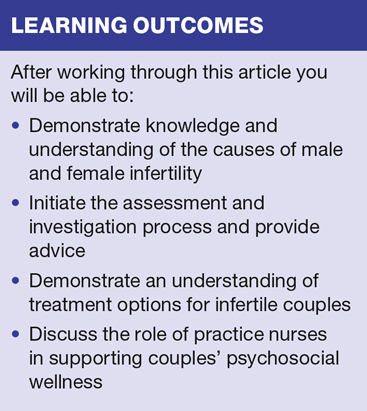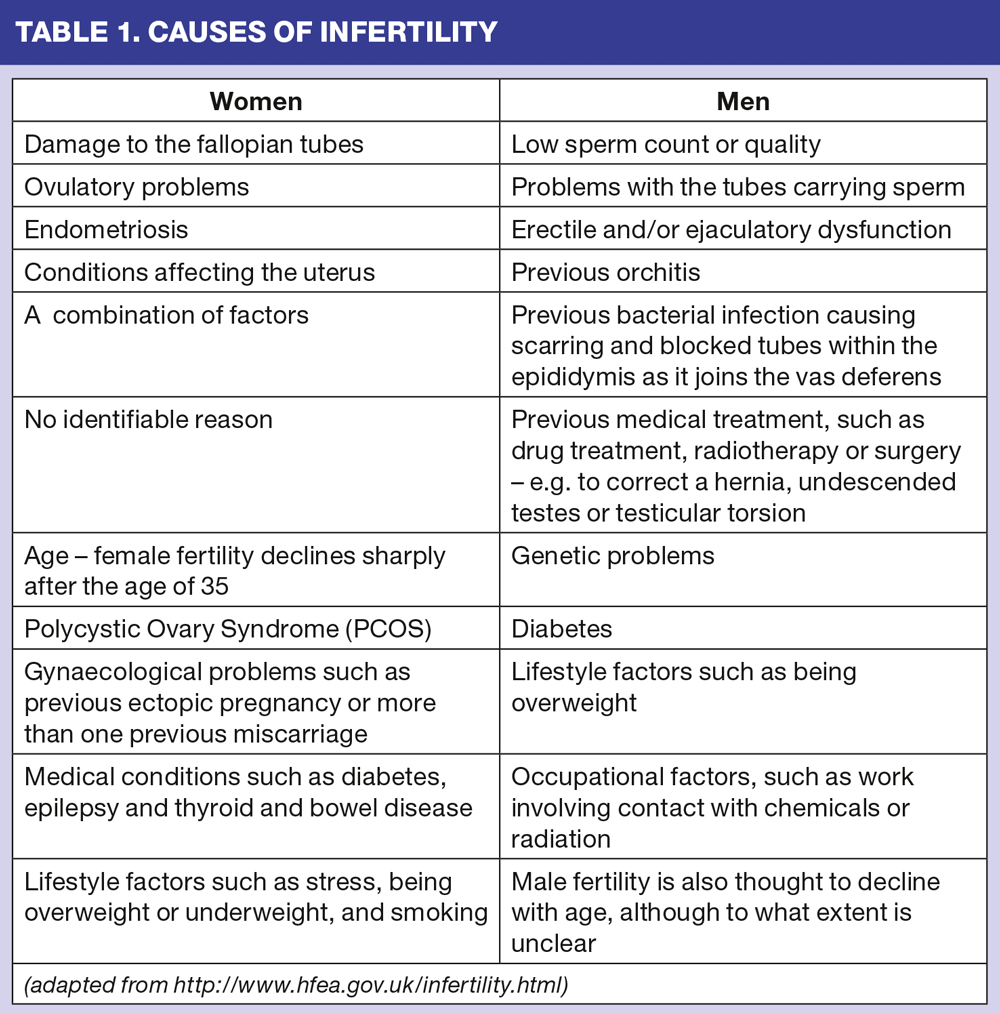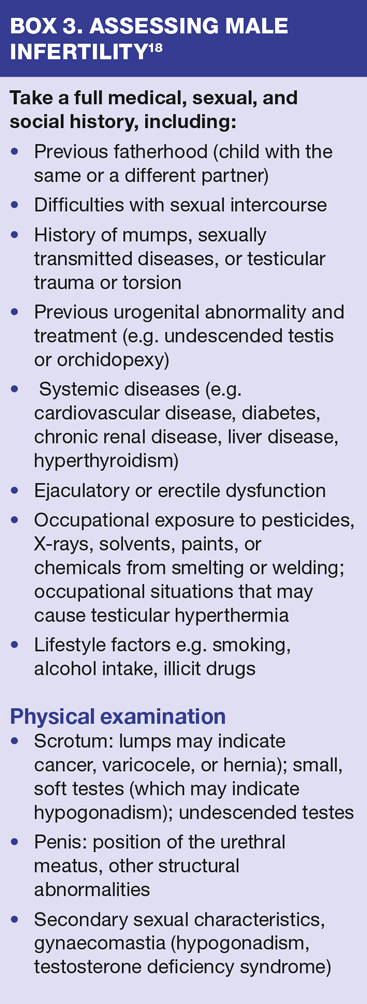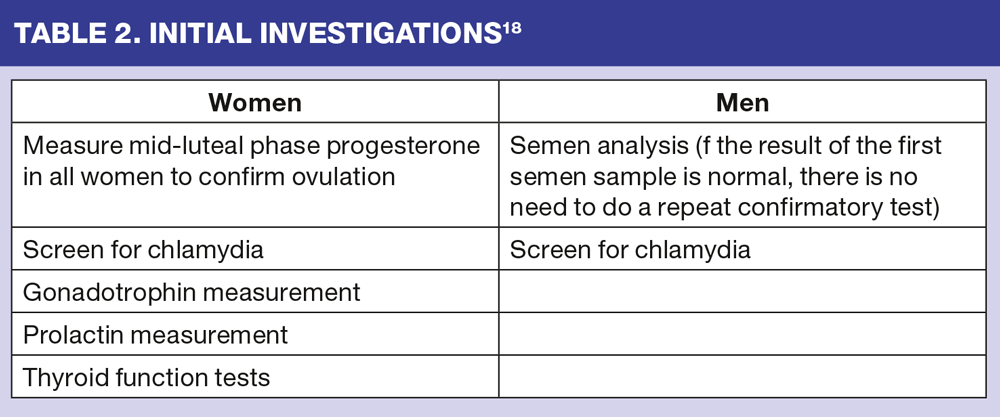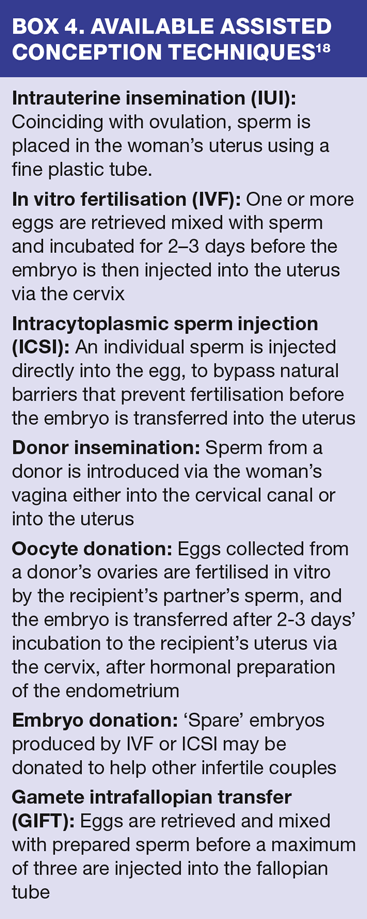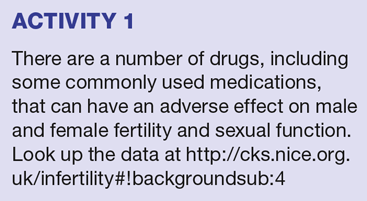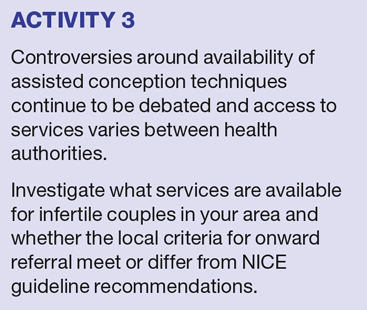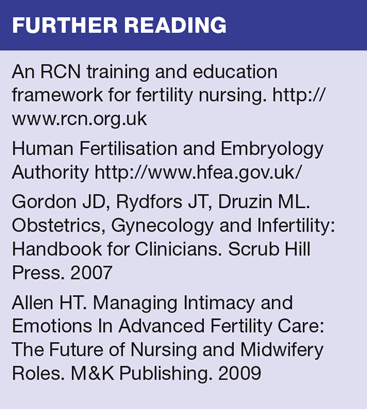Managing infertility in primary care
Marie Therese Massey
Marie Therese Massey
QN – Med, PGDip Medical Education, BMEd Sci, Nurse Prescriber, RSCN, RGN.
Senior Lecturer, Sheffield Hallam University, Nurse Practitioner Sexual Health, Sheffield
One in six couples experience difficulty conceiving at some point in their lives and will turn to primary care for help and advice. Practice nurses can play a key part in offering informed education, guidance and emotional support
Great strides have been made in the development of assisted conception techniques over the last three decades. For couples embarking on the journey of seeking treatment for infertility the emotional and psychological impacts can, however, be harrowing and can challenge even the strongest relationships.1 Most couples will start their journey in primary care and nurses in general practice are in a position to provide informed, evidence based advice in a sensitive and appropriate way.
Infertility is common and one in six couples experience difficulty conceiving at some time in their lives.2 NICE defines infertility as:
‘Failure to conceive after regular unprotected sexual intercourse for 2 years in the absence of known reproductive pathology’.3
NICE guidelines state that: ‘A woman of reproductive age who has not conceived after 1 year of unprotected vaginal sexual intercourse, in the absence of any known cause of infertility, should be offered further clinical assessment and investigation along with her partner, with earlier referral to a specialist if the woman is over 36 years of age’.3
Many of the initial assessments and investigations will take place in general practice. Knowledge and understanding of the process prior to onward referral is fundamental to the nurse’s role if they are to provide effective clinical and emotional support.
THE FEMALE REPRODUCTIVE CYCLE
The female reproductive organs consist of the ovaries, fallopian tubes, uterus, cervix and vagina. The reproductive cycle occurs at approximately monthly intervals, is primarily controlled by hormones and can be divided into four phases:
1. Pre-ovulatory phase
2. Ovulation
3. Post-ovulatory phase
4. Menstrual phase.
The cycle is initiated in the pre-ovulatory phase by gonadotrophin releasing hormone (GnRH). This is secreted from the hypothalamus and stimulates the pituitary gland to release luteinizing hormone (LH) and follicle stimulating hormone (FSH). These two hormones are responsible for ovum development and the production of oestrogen and progesterone. A surge of LH midway through the cycle triggers rupture of the follicle and release of the ovum – ovulation – which then drifts towards to fallopian tube and onwards to the uterus.
In the post-ovulatory phase the follicle transforms into the corpus luteum. Oestrogen and progesterone continue to be secreted and are responsible for the proliferation of the endometrium in preparation for implantation of the fertilised ovum. If fertilisation does not take place then the menstrual phase occurs, where the ovum, along with other products of proliferation such as endometrial cells, blood and mucous are shed vaginally, typically over a period of 5-7 days.
The length of the reproductive cycle varies between women with the average cycle lasting 28 days. The post-ovulatory phase, however, is considered to be constant at 14 days. Depending on the length of the cycle a women could ovulate on day 7 in a 21 day cycle or day 21 in a 35 day cycle. An ovum can be fertilised by sperm during the 12 to 24 hours after it has been released from the ovary.
THE MALE REPRODUCTIVE CYCLE
The main male reproductive organs are the penis, testes, epididymis and vas deferens. The production of sperm is a complex process known as spermatogenesis and, like the female reproductive cycle, is under the control of hormones, including testosterone. Testosterone is produced by the testes and is also responsible for development of the male sex organs and masculine characteristics.
The testes are composed of numerous thin, tightly coiled tubules – the seminiferous tubules. Within the walls of the tubules are many, randomly scattered cells, called sertoli cells. These support and nourish immature sperm cells, giving them nutrients and blood products. Sperm cells are continually being produced by the testes and must mature before they can fertilise an ovum. Once a sperm has matured, it is transported through the long seminiferous tubules and is stored in the epididymis of the testes until it is ready to leave the body. Sperm can survive in the fallopian tubes for up to seven days, so fertilisation can occur even if sperm entered the fallopian tubes before an ovum was released.
CAUSES OF INFERTILITY
Fertility problems can occur in both men and women and, in some couples, both partners may be affected. The common causes are summarised in Table 1 and fall generally into two headings; hormonal causes and structural causes, including fallopian tube damage and sperm dysfunction.
It is worth being aware of a number of less common, although equally important causes of infertility: cervical mucus hostility, where sperm cannot penetrate the cervical mucus, or the production of sperm antibodies by the woman, resulting in sperm immobilisation, are both causes, although rare, of female infertility.4 In recent years lifestyle factors, including obesity or extreme weight loss, increased alcohol consumption, environmental factors and smoking, increasingly influence conception success rates.5-7 There are a number of drugs that can have an adverse effect on fertility and sexual function in both men and women (see activity 1). However, in 25% of cases no identifiable cause can be found, increasing frustration and anxiety for many couples.3
Male infertility
In 44% of men with infertility no underlying cause is found, other than idiopathic oligo-astheno-teratozoospermia (OAT) syndrome (sperm dysfunction), or the complete absence of sperm (azoospermia).8 However there are a number of male structural causes, including obstruction of the vas deferens or the presence of a varicocele, where the veins in the scrotum are enlarged, which may cause low sperm production and decreased sperm quality because of increased testicular temperature and intratesticular pressure.9
Chromosomal or congenital factors of male infertility include Klinefelter’s syndrome, testicular dysgenesis and the complete absence of testes. Infertility can also follow:
- Trauma to the male genital organs, such as torsion or surgery
- Epidydymo-orchitis (mumps orchitis)
- Severe hypospadias, resulting in difficulty with intercourse
- Long-term sexual dysfunction.8
Female infertility
The main causes in women are:
- Ovulatory disorders – 25% of couples
- Tubal damage – 20% of couples
- Uterine or peritoneal disorders – 10% of couples
Gamete or embryo defects, uterine or endometrial factors, and pelvic conditions such as endometriosis may also be of significance.3
Ovarian dysfunction
Primary causes of ovarian failure include genetic disorders, such as Turners Syndrome or being a carrier for the fragile X gene. It can also be the result of treatment, such as chemotherapy or radiotherapy.
The most common cause of secondary ovarian dysfunction is polycystic ovary syndrome (PCOS). Reduced production of FSH in PCOS is associated with failure of follicular development so that the ovum is unable to mature. PCOS also leads to increased ovary size and the presence of follicular cysts. The condition is characterised by:
- Elevated LH/FSH and testosterone levels
- Anovulation
- Irregular cycles
- Hirsutism
- Acne
- Obesity.
Other hormonal causes include hypothalamic pituitary failure. The hypothalamus and pituitary are responsible for the production of GnrH, FSH and LH to initiate ovum maturation and failure to control this process will result in the inability of the ovary to produce mature ova. Pituitary failure can be caused by damage to the pituitary, e.g. from pituitary tumours such as a prolactinoma. Hypothalamic failure can be congenital, such as in Kallman’s Syndrome. Hypothalamic amenorrhoea is related to suppression of normal GnrH caused by excessive weight loss, exercise or stress. Other underlying causes of hypothalamic pituitary failure include ovarian cancers or the use of anabolic steroids.
The signs and symptoms associated with ovarian dysfunction are summarised in Box 1.
Structural causes
The most common structural reason for failure to conceive is damage or scarring of the fallopian tube, preventing the successful passage of the ovum towards the uterus for implantation. The major cause of tubal damage is pelvic inflammatory disease, usually following a sexually transmitted infection (STI) such as chlamydia trachomatis or gonorrhea. Sadly, the asymptomatic nature of these STIs, particularly chlamydia, has led to this becoming a major cause of infertility in today’s society.10
Other causes of tubal damage include tubal surgery resulting in adhesions; ectopic pregnancy; septic abortion and ruptured appendix.11 Submucosal fibroids may distort the uterine cavity and impair implantation.12
Endometriosis
In endometriosis the endometrial cells that line the uterus grow outside the uterine cavity but are influenced and respond to the hormonal changes during the menstrual cycle in the same way as those lining the womb. Symptoms include period pain (that can be severe), painful sexual intercourse, pelvic pain and dysuria. Endometriosis is common and 20-40% of infertile women are affected. The condition can result in ovulatory dysfunction and peritoneal inflammation.11
Chronic disease
Underlying chronic illness, including disorders of the thyroid such as hyperthyroidism and hypothyroidism and adrenal abnormalities such as Cushing’s syndrome, may lead to menstrual disorders, ovulatory dysfunction and anovulation. Other debilitating diseases, including cancer, uncontrolled diabetes and HIV/AIDs, can result in amenorrhoea and anovulation.
ASSESSMENT AND INVESTIGATION
The assessment and investigation process to establish the cause of infertility should be approached with sensitivity and compassion and NICE recommends that couples should be seen together.3 However, initiation of clinical investigations is not recommended until the couple has been unable to conceive after 1 year of unprotected intercourse.
The role of primary care in supporting infertile couples includes conducting the initial assessment and investigations, providing lifestyle advice including obesity management, smoking cessation and alcohol moderation and, where appropriate, medical interventions and onward referral. Women should be advised on preparing for pregnancy, for example, to take folic acid and check their rubella and cervical smear status. Conservative management should also include a medication review, and advice on the importance of regular sexual intercourse (every 2-3 days).
NICE provides comprehensive guidelines on what should be included in an initial assessment of infertility (Boxes 2 and 3) and initial investigations. (Table 2)
TREATMENT
Primary care nurses involved in the clinical interventions associated with treatments for infertility, need to be knowledgeable as they may be asked for advice during consultations. Any advice on treatments should be accurate and up to date as misinformation can lead to misinterpretations and false hopes.
Medical intervention
After lifestyle advice and following assessment, the main treatment for persistent anovulation initiated in primary care is ovulation induction with the anti-oestrogen drug, clomifene, which is recommended by NICE as first line treatment. Ultrasound monitoring, to assess follicle growth and to determine whether the appropriate dose is being used in order to prevent multiple pregnancies, is advised for the first month’s treatment. Common side effects include stomach cramps, nausea, bloating and hot flushes. Clomifene should not be used for more than 6 months.3
Other medical interventions recommended by NICE for women with hypothalamic pituitary dysfunction include metformin and gonadotrophins. Metformin, however, is associated with more gastrointestinal side effects, and gonadotrophins are associated with a higher risk of multiple pregnancies. Dopamine agonists can be considered for women with ovulatory disorders secondary to hyperprolactinaemia.
Gonadotrophins can be used to restore fertility in men with hypogonadotrophic hypogonadism.
Surgical intervention
In some cases, referral for surgical intervention may be indicated. Examples of surgical treatments include tubal microsurgery, catheterisation or cannulation. This can improve the chance of pregnancy in women with proximal tubal obstruction. In women with endometriosis, treatment such as surgical ablation or resection of endometriosis plus laparoscopic adhesiolysis, can be an option.
In men with obstructive azoospermia, surgical correction of epididymal blockage is likely to restore patency of the duct and improve fertility.
Assisted conception
Assisted conception can be defined as treatments that deal with means of conception other than normal coitus. All assisted reproduction in the UK is licensed by the Human Fertility and Embryology Authority (HEFA). Box 4 gives an overview of the available procedures.
The referral criteria for assisted conception in the UK are provided by NICE. Despite this the provision of IVF treatment varies between health authorities and there is no obligation for them to adhere to the guidelines. Consequently the opportunities for some couples to seek assisted conception will be limited, resulting in some couples seeking private treatment.
EMOTIONAL SUPPORT
Nurses in general practice who have additional training and support are well placed to assist with initial evaluation and investigations and can offer informed pre-conception and lifestyle advice. However, the emotional and psychological effects of infertility should not be underestimated and nurses often feel they lack the skills to provide support. Yet it is often the nurse that couples turn to for understanding and assistance during their journey to conception.13 Building a good rapport at an early stage and spending time exploring the expectations and anxieties of the couple will allow a greater understanding of their needs.
Response to the experience of infertility is variable. It is influenced by the type and duration of the cause of infertility, the treatment and the couple’s own emotional resilience to their situation.1,13 Studies investigating the effects of infertility on women have highlighted how, for some, womanhood equals motherhood, and failure to conceive results in feelings of guilt and self-blame, which can be compounded by the attitudes of family members. This can bring isolation and depression as their life’s expectations are not realised.2,14
Other emotions experienced by infertile couples are associated with loss: grief and sorrow as they mourn for the unborn child and the future they will not have. It is therefore not unusual for a significant strain to be put on couples’ relationships.15,16 Couples are encouraged to have sexual intercourse regularly, but infertility can adversely affect their sex lives and result in negative feelings towards their partner. Infertility was cited by some couples as the cause of their marriage breakdown.1,17 However, not all couples will experience the same emotions and there is some evidence from these studies that, for some, infertility and the journey towards fertility has brought them closer.
Practice nurses should be aware of the emotional effects that couples may experience. We are in a good position to identify those who are more at risk of emotional distress and can advise referral for counselling at an early stage. Most infertility clinics offer professional counselling and couples should be encouraged to access the support they provide.
SUMMARY
Infertility is common and most couples will seek initial advice and treatment in general practice, where the initial assessment and investigations may be carried out before onward referral, and for clinical support during and after treatment. However, the emotional and psychological effects of infertility and the strain of undergoing infertility treatments can have devastating consequences for some couples. Practice nurses are ideally placed to support couples on their journey. However infertility treatment can be complex and adequate knowledge and skills are needed to provide informed care and advice.
REFERENCES
1. Lindsey B, Driskell C. The psychology of infertility. International Journal of Childbirth Education 2013;28(3):41-47
2. Ferland P, Caron S. Exploring the long term impact of female infertility: A qualitative analysis of interviews with postmenopausal women who remained childless. The Family Journal 2013;21(2):180-88
3. NICE CG 156. Guideline treatment recommendations for people with fertility problems, 2013 https://www.nice.org.uk/guidance/cg156/resources/updated-nice-guidelines-revise-treatment-recommendations-for-people-with-fertility-problems/
4. Symonds EM, Symonds IM. Infertility and disorders of sexual function. In: Essential obstetrics and gynaecology. 4th edn. London: Churchill Livingstone. 2004 Chapter 19. 261-265.
5. Hull MG, North K, Taylor H. et al. Delayed conception and active and passive smoking. The Avon Longitudinal Study of Pregnancy and Childhood Study Team. Fertility and Sterility 2000;74(4):725-733
6. Kort HI, Massey JB, Elsner CW. et al. Men with high body mass index values present with lower numbers of normal-motile sperm cells. Abstract no. P-335. Fertility and Sterility 2003; 80(Suppl 3):238-238.
7. Wang JX, Davies M, Norman RJ, et al. Body mass and probability of pregnancy during assisted reproduction treatment: retrospective study. BMJ 2000;321:1320 http://www.bmj.com/content/321/7272/1320
8. Jungwirth A, Diemer T, Dohle GR, et al. Guidelines on male infertility. European Association of Urology, 2012 www.uroweb.org
9. Wright EJ, Young GP, Goldstein M. Reduction in testicular temperature after varicocelectomy in infertile men. Urology 1997;50:257–9
10. Lazaro N. Sexually transmitted infections in primary care. 2nd edn. Royal College of General Practitioners and British Association for Sexual Health and HIV, 2013. www.bashh.org/Guidelines/
11. Speroff L, Fritz M. Clinical gynaecologic endocrinology and infertility. Philadelphia PA: Lippincott Williams and Wilkins; 2005
12. Monga A, Dobbs S. (Eds.) Gynaecology by ten teachers. 19th edn. London: Hodder & Stoughton Ltd; 2011
13. Sherrod RA. Emotional aspects of infertility. Journal of Psychsocial Nursing and Mental Health Services 2004;42(3):40-47
14. Engler N. The psychological impact of infertility and its treatment. Harvard Mental Health Letter 2009;25(11):1-3
15. Barber DA. Fertile Field. Nursing Standard 2000;14(26):77-78
16. Gonzalez LO. Infertility as a transformational process. A framework for psychotherapeutic support of infertile women. Issues in Mental Health Nursing 2000;21:619-633
17. Sundby J. Long term Psychological consequences of infertility: A follow-up study of former patients. Journal of Women’s Health 1992; 1(3): 209-217
18. NICE Clinical Knowledge Summaries. Infertility, 2013; http://cks.nice.org.uk/infertility
Related articles
View all Articles
